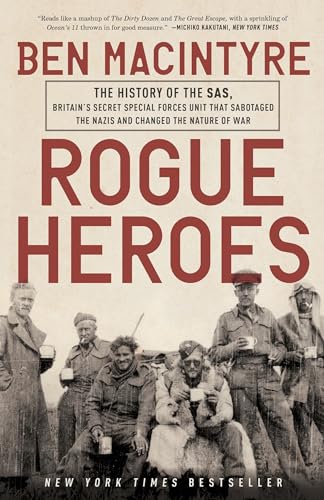Welcome to my review of the book ‘Rogue Heroes’! If spy thrills and wartime tales are your cup of tea, you’re in for a ride. This book takes you on a wild journey through history, packed with daring missions, colorful characters, and sneaky tactics. Stay with me as we unravel its pages, and I’ll share the highs, the lows, and why you might want to add this one to your collection. Just don’t expect me to get every spelling right—I’m only human!
Rogue Heroes: A Thrilling Journey
In a nutshell
“Rogue Heroes” by Ben Macintyre is a riveting non-fiction book that takes us into the world of the Special Air Service (SAS) during World War II. This historical adventure transports readers to a time of daring and innovation, highlighting unconventional warfare tactics that changed the course of history.
Macintyre, known for his engaging storytelling, weaves a narrative filled with espionage, courage, and resilience. The book explores themes of leadership, the chaos of war, and the human spirit’s capacity to adapt in extreme situations. It’s a page-turner that will appeal to history buffs, military enthusiasts, and anyone seeking an exciting, informative read.
How “Rogue Heroes” Influences Modern Warfare
“Rogue Heroes” by Ben Macintyre gives us a thrilling look at the creation and heroics of the SAS during World War II. These secret agents did it with style, flair, and a touch of madness, you know, like how I fight my cats for the last piece of chicken. Now, how does this relate to modern warfare, you ask?
Before reading “Rogue Heroes,” I thought modern warfare was all about drones and robots, but this book made me realize it’s not just about tech. It’s about the guts, brains, and a bit of madness in strategy too. The SAS taught today’s troops the power of surprise and unconventional tactics. They brought new meaning to teamwork, which I totally support because I’m the team captain of my friend’s Dungeons & Dragons campaign. That’s serious stuff, folks!
The SAS’s lessons have been passed down, but they also did some things wrong. They sometimes underestimated enemies or over-relied on certain tactics. It’s like using the same joke over and over at parties; people get numb to it. Modern warfare folks have tried learning from these quirks, yet still, you see similar mistakes. The book shows modern armies need to think on their feet, adapt fast, and not get too cocky.
On the flip side, this book highlights the significant impact of leadership. The charisma and boldness of characters like David Stirling remind us that courage goes a long way in modern military power. In today’s world, leaders in warfare need to be a blend of bold, cunning, and sometimes a touch crazy, just like my Aunt Edna during bingo night.
Next, let’s explore the historical accuracy of “Rogue Heroes” and Ben Macintyre’s meticulous research.
Exploring Historical Accuracy and Research in Rogue Heroes
The book Rogue Heroes offers an exciting look into the formation of the SAS, but you might be wondering, “How accurate is it, really?” Well, rest assured, this gripping tale stands tall when it comes to historical accuracy. The author, Ben Macintyre, pulls off a Herculean effort! He dives into piles of military records, dusty archives, and interviews with surviving members to piece together an unforgettable narrative. It’s like a time machine on paper. I almost expected to see tea-stained maps and dusty compasses fall out of the book!
Now, if you’re a history buff like me, you might get a kick out of spotting those meticulous details. Macintyre’s thorough research ensures that the chaotic, daring exploits of the early SAS are portrayed with a healthy dose of truth. And believe it or not, the crazy stuff in the book is not just fiction sprinkled in for effect. From night raids to inventive sabotage tactics, the accuracy makes you wonder if the SAS ever sleep—or if they were really just caffeine-fueled ninjas in khaki shorts.
Of course, with such precise research, it’s only fair to mention that keeping track of all these names and operations could feel like you’re back in school trying to remember the periodic table. A glossary might’ve helped! But that’s a small price to pay for such an enriching experience.
So, stay tuned for the next section, where we’ll peek behind the curtains and find out what the SAS blokes went through. Trust me, it’s like finding your grandad’s old diary, full of tales you wouldn’t believe!
Personal Stories of SAS Members in Rogue Heroes
Everyone loves a good personal story, right? They tug at the heartstrings, inspire awe, or make us laugh till our sides hurt. And boy, oh boy, does Rogue Heroes deliver on that front! The book is full of thrilling tales from the Special Air Service (SAS) members themselves. These folks weren’t just soldiers; they were mavericks, rebels, and daredevils, and their stories leap off the page like an action movie screenplay. It’s like hearing about your grandpa’s epic adventures, only juiced up with adrenaline.
One unforgettable tale involves a member who, rather than follow orders to sneak quietly past enemy lines, decided to impersonate a drunken camel herder. He pulled it off, much to everyone’s shock and disbelief. Then, there’s the tale of a guy who thought it was a grand idea to storm an enemy base wearing nothing but his underpants and a cap. These stories add a human touch to the grand exploits of the SAS, reminding us they were ordinary folks doing extraordinary things. The way these brave men share their experiences is both raw and inspirational.
The humor, courage, and ridiculously bold antics within these stories are pure gold. But it’s not all laughs. Some tales expose the harsh realities of war, making you realize the insane bravery it took to be part of the SAS. These personal stories really anchor the book, giving it a pulse that keeps readers engaged.
Next up, we’ll chat about how the writing style and narrative flow of this incredible book are as smooth as a buttered slide. Stay tuned!
Engaging Narrative and Writing Style in Rogue Heroes
Reading Rogue Heroes was like sitting around a campfire with the most entertaining storyteller. The writing style felt like a pop song—catchy, punchy, and keeps you coming back for more. Ben Macintyre, the author, has this knack for weaving historical facts with a narrative flair that makes you forget you’re learning something. Forget the snooze-fest history classes. This is the real deal!
Macintyre’s ability to bring out the personalities of SAS operatives was mind-blowing. It’s like he dipped his pen in adventure ink. You can sense the adrenaline, the camaraderie, and yes, even the fear in each chapter. I laughed out loud at many of the witty quips, which made it feel personal. A book that makes you burst out laughing is a win in my book (pun intended!).
The narrative flow in Rogue Heroes is like a well-choreographed action film. There are no dragging moments to make you lose interest. Each page turn was a speedy car chase, never letting you hit the brakes. Just when you think you know what happens next, boom, a plot twist! It’s like a roller coaster the way it twirls through history, keeping both my heart and brain engaged.
However, sometimes the story jumped a bit too fast, leaving me flipping back to make sure I didn’t miss anything. But hey, it kept me on my toes!
If you love a good historical romp with a splash of humor, Rogue Heroes is your ticket. I recommend this joyride through history. Just buckle up and hold on tight!
Conclusion
Despite some minor historical inaccuracies, ‘Rogue Heroes’ offers an exciting narrative that’s both entertaining and informative. Macintyre’s writing style captivates with humor and insight into WWII’s wild SAS tales. The book’s a delightful read for anyone interested in history or fascinated by unconventional warfare. It’s a thrilling romp through time! That wraps up my review—thanks for joining me on this adventure.


